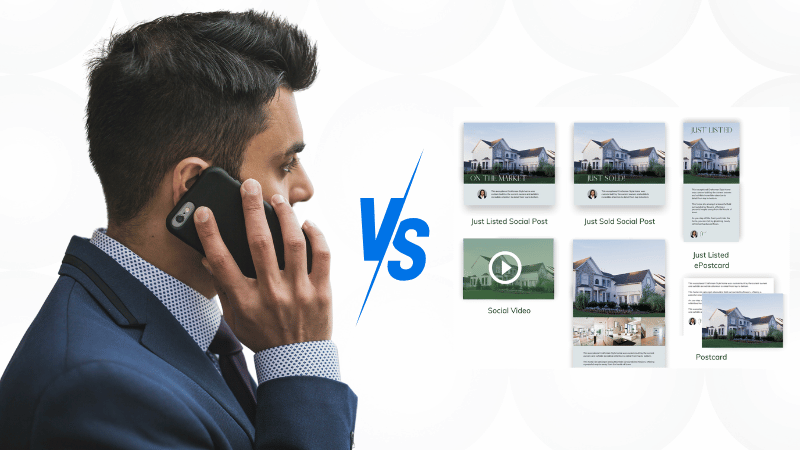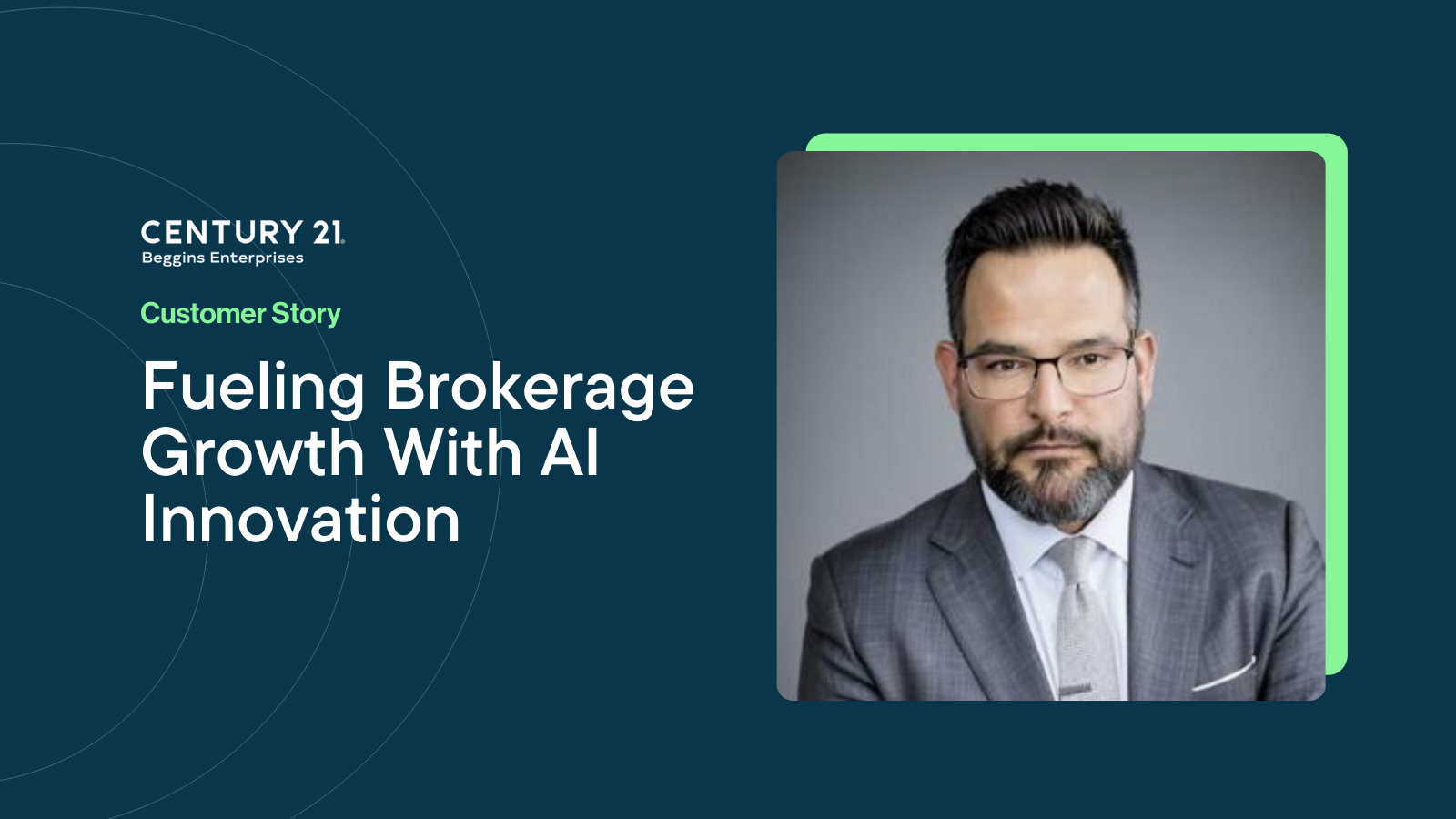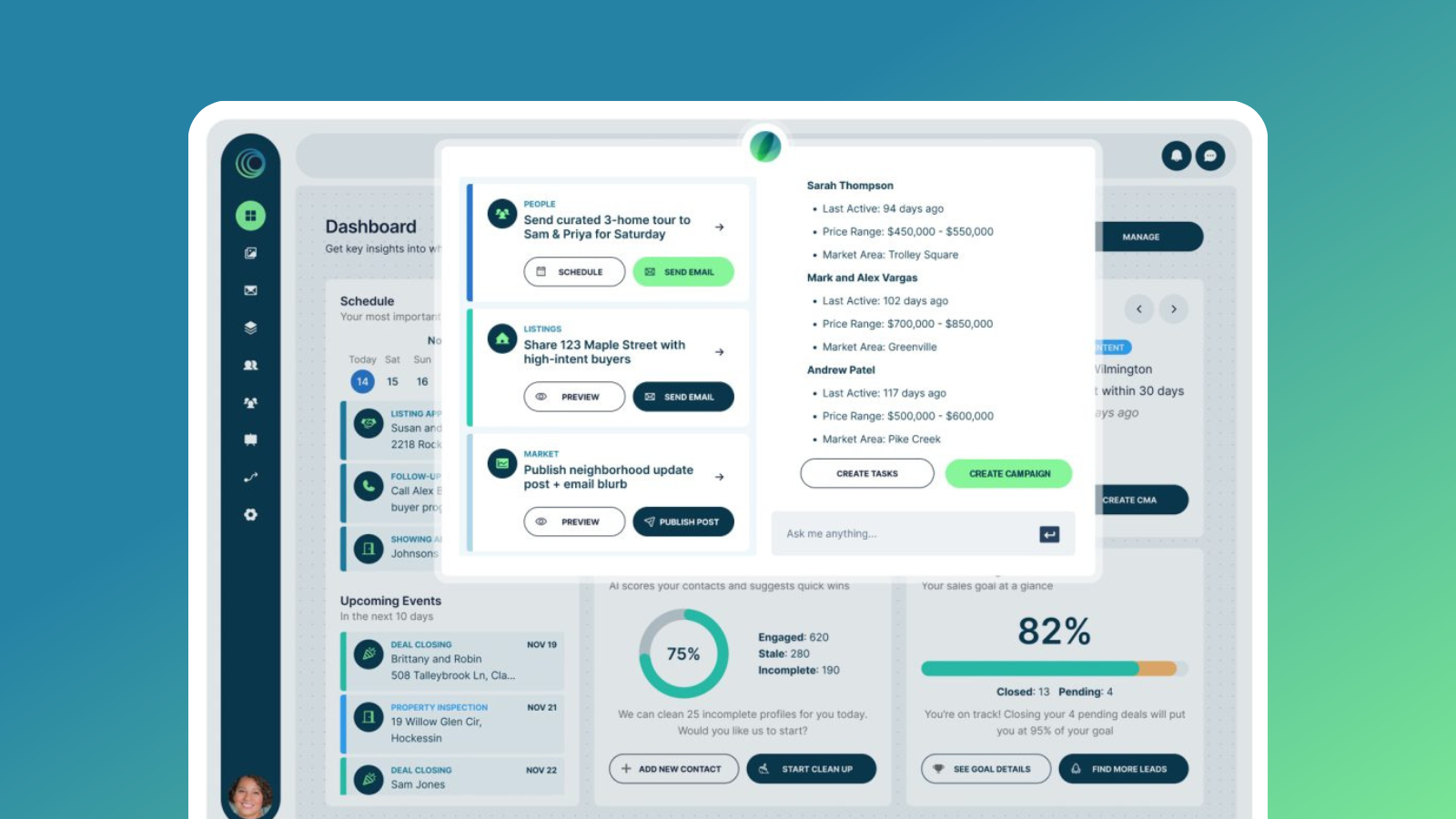Deciding where to put energy and resources into lead generation for real estate is critical. But what techniques and platforms really work?
The real estate landscape has shifted dramatically over the years, but one thing remains constant: the need for fresh leads. As the rise of digital marketing continues to revolutionize how agents capture and convert leads, does it mean that the tried and true techniques of yesterday are a thing of the past? Not just yet.
We take a deep dive of the pros and cons of both old-school and modern-day methods to help you beat the competition and generate leads in the real estate market.
Old school:
1. Cold calling

![]() The method:
The method:
One of the oldest (and, let’s be honest, least beloved) forms of lead generation for real estate. Cold calling involves pitching someone you’ve never met before about your real estate offerings.
![]() Pros:
Pros:
- Creates connection: Speaking directly with a potential lead can establish trust and rapport quickly.
- Low upfront cost: Other than your phone bill, there’s minimal financial investment.
![]() Cons:
Cons:
- Time-consuming: Cold calling requires hours of effort for a relatively low conversion rate.
- Rejections: It’s a tough job. The majority of your calls will end in hang-ups or disinterest.
![]() Verdict:
Verdict:
Despite its drawbacks, cold calling still generates results. With modern CRM systems, you can better target potential leads, improving the likelihood of converting someone into a client. But it’s a numbers game – persistence is key.
2. Direct mail campaigns

![]() The method:
The method:
Sending out postcards, flyers, or newsletters to a targeted mailing list to generate real estate leads.
![]() Pros:
Pros:
- Tangible collateral: A physical piece of mail can leave a lasting impression.
- Less competition: Many agents have abandoned direct mail in favor of digital marketing, meaning less competition in mailboxes.
![]() Cons:
Cons:
- Costly: Designing, printing, and mailing can get expensive fast.
- Low response rates: According to research from the Association of National Advertisers/ Data & Marketing Association, the average response rate for direct mail is between 2-5% depending on the targeting method used.
![]() Verdict:
Verdict:
For neighborhoods with older homeowners or long-time residents, direct mail can be effective. They may appreciate the traditional, tangible outreach. Pairing it with a digital follow-up (e.g., a postcard leading to a custom landing page) can boost your results.
Tip: MoxiImpress makes it easy to create and send direct mail postcards, so you can get your listings and brand in front of the target customer fast. Learn more about MoxiImpress’ automagic marketing here.
3. Open houses / Networking events

![]() The method:
The method:
Attending community events, hosting open houses, or joining local groups to meet potential clients in person.
![]() Pros:
Pros:
- Relationship building: Face-to-face interactions can create lasting relationships.
- Immediate feedback: You can gauge interest and adjust your pitch based on body language and conversation.
![]() Cons:
Cons:
- Time-consuming: Events can take up a lot of time and preparation, especially if you’re hosting.
- Limited reach: Your exposure is limited to those physically present.
![]() Verdict:
Verdict:
People still buy from people they know, like, and trust. While modern lead generation for real estate often focuses on digital outreach, in-person networking builds deeper connections. It’s especially effective in hyper-local markets or smaller communities.
4. Referral programs

![]() The method:
The method:
Leveraging your existing client base to generate leads through word of mouth and referral programs.
![]() Pros:
Pros:
- Build trust: Leads that come through referrals are pre-qualified and have a higher trust level.
- No direct cost: There’s typically no upfront cost to implementing a referral program.
![]() Cons:
Cons:
- Requires happy clients: Your referral program will only succeed if your past clients are satisfied.
- Limited reach: You’re limited to the size of your existing network.
![]() Verdict:
Verdict:
Referrals remain one of the most effective ways to generate leads. In fact, 39% of sellers find their real estate agent through a referral from a friend or relative . To supercharge your efforts, consider offering incentives for successful referrals.
Modern techniques:
5. SEO / Blogging

![]() The method:
The method:
Using search engine optimization (SEO) strategies to rank your website across search engines like Google for keywords related to real estate in your area.
![]() Pros:
Pros:
- Long-term results: Once you rank well on Google or YouTube, you can generate leads passively.
- High-intent leads: People who find you via search are often closer to making a real estate decision.
![]() Cons:
Cons:
- Takes time: Building authority and ranking for competitive terms like “homes for sale in [your city]” can take months or even years.
- Requires skill: SEO isn’t simple. You’ll either need to learn the ropes or hire an expert.
![]() Verdict:
Verdict:
Consumers search for real estate solutions online, with 97% of home buyers using online websites during their search. By optimizing your site for relevant keywords, you can attract leads that are actively looking for an agent.
Pro tip: MoxiWebsites gives your entire brokerage the power to publish fast, flexible, SEO-optimized sites in minutes. Learn more here.
6. Social media

![]() The method:
The method:
Leveraging platforms like Instagram, Facebook, LinkedIn, and TikTok for organic (not paid) lead generation for real estate.
![]() Pros:
Pros:
- Cost-effective: You can reach thousands of potential leads with little to no cost, although sometimes running contests or giveaways can increase costs.
- Targeting: Platforms allow you to create target audiences based on highly specific demographics and relevant behaviors (e.g., people interested in moving within six months).
![]() Cons:
Cons:
- Time-consuming: Maintaining an active presence, where you are creating conversation with your network, on even one platform can become a lot of work. Add on multiple platforms, and the task can turn truly overwhelming.
- Algorithm-dependent: Changes in algorithms can impact the visibility of your posts — for better or worse.
![]() Verdict:
Verdict:
Social media isn’t going anywhere, and it can have a meaningful impact on real estate agents’ businesses. In fact, 19% of all NAR members get 1-5% of their business from social media, and 10% get 6-10%. Each platform has its unique strengths and when it comes to driving organic lead generation in real estate; for example, Instagram allows you to showcase listings in a visually engaging way, Tiktok makes it easy to reach large audiences with video content that showcases your personality, and Facebook’s groups can help you target specific locations and neighborhoods.
The key is choosing a platform where you believe your network spends time already, that you can dedicate enough time to to showcase yourself in an authentic way.
7. Paid digital ads (Google, Facebook, etc.)

![]() The method:
The method:
Running pay-per-click (PPC) ads on Google or social media platforms to generate leads.
![]() Pros:
Pros:
- Quick results: Ads can generate leads almost immediately.
- Highly targeted: You can use a range of targeting options to ensure your ads are seen by the right people.
![]() Cons:
Cons:
- Costly: If not managed carefully, ad costs can quickly add up.
- Expertise required: Running successful ad campaigns requires knowledge of audience segmentation, copywriting, and ad design.
![]() Verdict:
Verdict:
Paid ads are excellent for driving traffic and leads fast. Google Ads, for example, allows you to target high-intent keywords, like “real estate agent in [city]” to capture leads who are ready to take action.
Pro tip: You don’t have to be a media maven to have effective digital ads – MoxiPromote makes it super simple. Learn how you can ace digital ads with MoxiPromote here.
8. Email marketing campaigns

![]() The Method:
The Method:
Sending targeted emails to a list of prospects or past clients. We know what you’re thinking – email is “modern”? While email is about as old-school as digital marketing gets, it’s highly effective, and we think it still warrants a place on the modern end of the spectrum for lead generation in real estate because it’s wholly online.
![]() Pros:
Pros:
- Cost-effective: Email marketing is one of the most affordable forms of digital marketing.
- High ROI: For every $1 spent on email marketing, businesses see an average return of $42 .
![]() Cons:
Cons:
- Requires contacts: You need to build and maintain a list of engaged prospects.
- Low open rates: If your subject lines and emails aren’t well-crafted, they can get lost in your clients’ sprawling inboxes.
![]() Verdict:
Verdict:
Email remains a valuable lead generation tool for real estate agents. Regularly sending newsletters, market updates, or property listings can keep you top of mind with potential clients.
9. Video marketing (YouTube, virtual tours)

![]() The method:
The method:
Videos posted on a platform that showcase listings, offer market insights, or provide virtual tours.
![]() Pros:
Pros:
- Engaging content: Video is one of the most engaging forms of content, keeping viewers on your site longer.
- Virtual access: Particularly in the post-pandemic era, virtual tours have become a critical part of the home-buying process.
![]() Cons:
Cons:
- Time-consuming: Creating high-quality videos takes time and effort.
- Expertise required: Not everyone is comfortable on camera or has the equipment to make professional videos.
![]() Verdict:
Verdict:
Video marketing is booming, and homebuyers have come to expect virtual tours. In fact, listings with video receive 403% more inquiries than those without. Platforms like YouTube also allow you to reach new leads through SEO-friendly video content.
Which Real Estate Lead Generation Techniques Should You Use?
Ultimately, the best strategy blends old-school tactics with modern-day methods. Cold calling and networking events can be valuable when trying to build a trusted, local network, while digital strategies like SEO, social media, and paid ads offer speed and scalability with skillfully selected target audiences. Combining multiple strategies will maximize your chances of success.
As the real estate landscape evolves, the key is to stay flexible, test various approaches, and track your results to see what works best for your real estate business.



